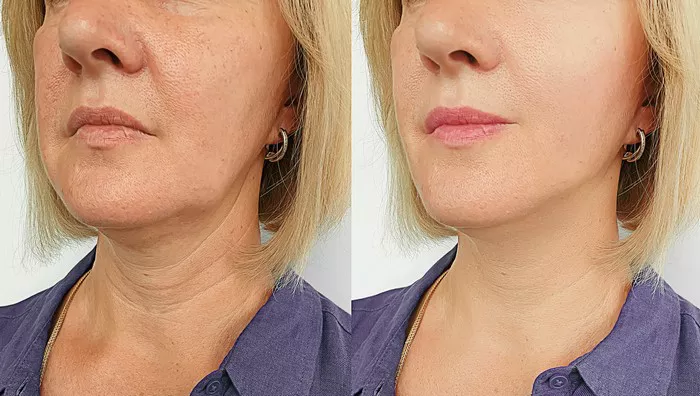As we age, our skin undergoes a number of changes that can affect its appearance and health. These changes are collectively referred to as aging skin, and can include wrinkles, sagging, dryness, and age spots. In this article, we will explore the causes of aging skin, the symptoms to look out for, and the treatment options available.
What is Aging Skin?
Aging skin refers to the changes that occur in our skin as we age. These changes can be caused by a variety of factors, including genetics, lifestyle choices, and environmental factors. Some of the most common changes associated with aging skin include:
Wrinkles: As we age, our skin loses elasticity and becomes less able to bounce back from the creases caused by facial expressions. This can lead to the formation of wrinkles, which can be especially noticeable around the eyes, mouth, and forehead.
Sagging: As skin loses elasticity, it can also begin to sag, particularly in areas like the cheeks, jowls, and neck.
Dryness: Aging skin can become drier and more prone to flakiness and itchiness. This is because the skin produces less oil as we age, leading to a loss of moisture.
Age spots: These are flat, brown spots that appear on the skin as we age. They are caused by an increase in melanin production, which can be triggered by sun exposure.
Causes of Aging Skin
Aging skin is caused by a variety of factors, including both intrinsic and extrinsic factors. Intrinsic factors are those that are determined by our genetics, such as the natural aging process. Extrinsic factors, on the other hand, are those that are influenced by external factors, such as lifestyle choices and environmental factors. Here are some of the most common causes of aging skin:
Natural aging process: As we age, the skin naturally loses elasticity and becomes thinner, making it more prone to wrinkles and sagging.
Sun exposure: Exposure to ultraviolet (UV) radiation from the sun can cause damage to the skin, including premature aging.
Smoking: Smoking can cause damage to the skin by reducing blood flow and oxygen to the skin, leading to wrinkles and a dull complexion.
Poor diet: A diet that is high in sugar and processed foods can contribute to inflammation in the body, which can accelerate the aging process.
Stress: Chronic stress can lead to increased levels of cortisol in the body, which can contribute to the breakdown of collagen and elastin in the skin.
Symptoms of Aging Skin
The symptoms of aging skin can vary depending on the individual and the extent of the damage. Some of the most common symptoms of aging skin include:
Wrinkles and fine lines: These are often the first signs of aging skin, and can be especially noticeable around the eyes, mouth, and forehead.
Sagging skin: As skin loses elasticity, it can begin to sag, particularly in areas like the cheeks, jowls, and neck.
Dryness and itchiness: Aging skin can become drier and more prone to flakiness and itchiness, which can be uncomfortable.
Age spots: These are flat, brown spots that appear on the skin as we age. They are caused by an increase in melanin production, which can be triggered by sun exposure.
Treatment Options for Aging Skin
While aging skin is a natural part of the aging process, there are a number of treatment options available to help improve the appearance and health of the skin. Here are some of the most common treatment options for aging skin:
Topical treatments: There are a variety of topical treatments available that can help improve the appearance of aging skin, including retinoids, antioxidants, and alpha-hydroxy acids.
Injectables: Injectables like Botox and dermal fillers can help reduce the appearance of wrinkles and fine lines by relaxing facial muscles and restoring volume to the skin.
Laser and light therapies: These treatments use lasers and other light-based devices to stimulate collagen production and reduce the appearance of wrinkles and age spots.
Chemical peels: Chemical peels use a solution to remove the outer layer of the skin, revealing smoother, more youthful-looking skin underneath.
Surgical procedures: In some cases, surgical procedures like facelifts and brow lifts may be necessary to address more severe signs of aging.
Prevention of Aging Skin
While there is no way to completely prevent aging skin, there are steps you can take to help slow down the aging process and keep your skin looking healthy and youthful. Here are some tips for preventing aging skin:
Protect your skin from the sun: Wear sunscreen with at least SPF 30 every day, and avoid spending too much time in direct sunlight.
Quit smoking: Smoking can cause damage to the skin and accelerate the aging process, so quitting smoking is an important step in maintaining healthy skin.
Eat a healthy diet: A diet that is rich in fruits, vegetables, and healthy fats can help keep your skin looking healthy and youthful.
Stay hydrated: Drinking plenty of water can help keep your skin hydrated and prevent dryness and flakiness.
Manage stress: Chronic stress can contribute to the breakdown of collagen and elastin in the skin, so finding ways to manage stress is important for maintaining healthy skin.
Conclusion
Aging skin is a natural part of the aging process, but there are steps you can take to help slow down the process and keep your skin looking healthy and youthful. By protecting your skin from the sun, quitting smoking, eating a healthy diet, staying hydrated, and managing stress, you can help keep your skin looking its best. And if you do experience signs of aging skin, there are a variety of treatment options available to help improve the appearance and health of your skin.


